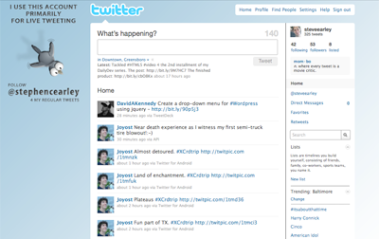There is no mobile Web and desktop Web. There is just the Web.
As our favorite content follows us to new and smaller screens, it’s a refrain you’re like to hear more and more from webdev pundits.
If you ask me, it’s semantics. Whether or not it’s technically accurate, given the differences between who tends to access (young, minorities) content on mobile devices versus desktops and laptops and what users can do (call, text, geolocate), can’t do (often, javascript and/or Flash) and like to do (make decisions, multi-task, kill time) once they get there, “mobile Web” is a useful term.
That out of the way, there were three developments this week in the mobile-news-social sphere indicative of the desktop Web and mobile Web merging closer together.
Come Fly with us (on mobile first)
The first, most recent, and certainly the one making the biggest splash, is #NewNewTwitter, playfully branded with the tagline “Fly.”
Not only are the design and functionality of Twitter’s desktop Web, mobile Web and mobile app versions becoming more synchronized, there’s also a cognizant effort by Twitter to get desktop-only users spending time on its mobile platforms.
This push became evident last spring when Twitter placed pretty direct messaging on Twitter.com’s log-out landing page: “You’ve signed out of Twitter. Now go mobile.”
Just as aggressive was rolling out #NewNewTwitter to mobile.twitter.com and iPhone and Android apps first and letting those who download one of the apps get the revamp early on desktop as well. The smartphone prop at the beginning and end of the promotional video likewise encourages a cross-platform experience.
Responding to multi-platform challenges and opportunities
While the average user’s browser needed some time to catch up, responsive design, essentially using CSS media queries and HTML5 semantic elements to accommodate varying screen sizes, has been around for a while. That it’s suddenly getting so much attention (I’m thinking foremost of the BostonGlobe.com launch) as a silver bullet for publishing to multiple platforms – it’s not, there are no silver bullets – has perplexed me.
One of the best of the new nonprofit journalism enterprises out there, ProPublica, explains the advantages of responsive design well in this post about its recent website redesign. Two of the biggest are that developing adaptive websites is less intensive than the user agent sniffing and native app alternatives and that, unlike apps, it connects content to the full, open Web. This has strong SEO, link economy and user experience benefits, but it also, ProPublica astutely points out, reduces the level of engagement required to get users using in the first place:
We think this explains a phenomenon we’ve noticed – that though we’ve had huge uptake of our mobile apps, we don’t see very much day-to-day usage compared to the number of people who come to our site on their smart phones. It’s our hypothesis that it’s because people have to remember to open up the app to see what’s new every day.
One native app, under Apple, but a Web version for all
The New York Times’ new Election 2012 app, available as a native app only for iPhone, is turning heads for its heavy and prominent aggregation. The Gray Lady also deserves a nod for publishing a Web app version at mobile-elections.nytimes.com accessible on Android and BlackBerry smartphones and even more basic devices.
Perhaps this is a cost-saving measure. Or maybe they ran out of time to build out more native verisons – the Iowa caucuses are less than a month away. I’d offer, however, that for an app built around links, it would be foolish not to have a version on the open Web. A version users can search to. A version users can share (here’s the deets on my home state’s primary!). A version the aggregated (and others) can link back to.





 Name a social media app and you’ll likely find it on Brian Solis’
Name a social media app and you’ll likely find it on Brian Solis’